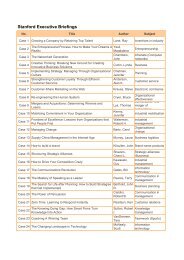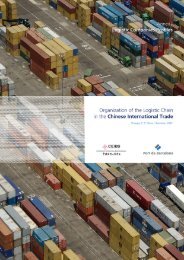Untitled - China Europe International Business School
Untitled - China Europe International Business School
Untitled - China Europe International Business School
Create successful ePaper yourself
Turn your PDF publications into a flip-book with our unique Google optimized e-Paper software.
Organization of the logistic chain in the Chinese international trade<br />
Sea transportation-Shipping lines<br />
Shippers find the sea-transportation one of the most challenging parts of the logistic chain between<br />
<strong>China</strong> and <strong>Europe</strong>. The high variability of the sea-freight rates, shortage of space in vessels in the peak<br />
seasons, the unreliability of the vessels schedules are main concerns for the companies.<br />
Big cargo owners usually negotiate directly long-term agreements with shipping lines while shippers<br />
with small and medium cargo volumes rely on forwarders for the relationship with shipping lines.<br />
<strong>International</strong> forwarders usually have long-term relationships with shipping companies in order to<br />
ensure cargo space and favorable freight rates for their customers. These agreements between<br />
forwarders and shipping lines are generally negotiated at a global level, involving main headquarters.<br />
Shipping companies, in the <strong>China</strong>-<strong>Europe</strong> trade, need to deal with the up and downs of the demand<br />
market and of their profits. The selection of their customers has to ensure volume and profitable freight<br />
rates. Shipping companies need to find a balance between direct customers, which are big cargo<br />
owners with stable demand but that involve lower freight rates, and small and medium size customers<br />
managed through forwarders.<br />
The destination of the shipper’s cargo and the type of cargo are key aspects in the negotiation with<br />
shipping companies. Container imbalance in flows between <strong>Europe</strong> and <strong>China</strong> is one of the main<br />
challenges for shipping companies which try to minimize destinations with no return-cargo, as moving<br />
empty containers can ruin profitability. Owners of hazardous and other special cargo can also meet<br />
more difficulties to ship their cargo as shipping companies, especially in peak seasons, tend to turn<br />
down this cargo in the first place.<br />
Ports and shipping routes<br />
The trade from <strong>China</strong> to <strong>Europe</strong> is mainly directed to the North <strong>Europe</strong>an ports. The main ports of<br />
destination are Rotterdam, Hamburg, Antwerp, Bremen, Le Havre and Zeebrugge, (Felixstowe and<br />
Southampton) from where the cargo is distributed within <strong>Europe</strong>. Only around 20% of the cargo is<br />
shipped to Mediterranean ports. Northern and Mediterranean range of ports are considered to<br />
embrace different markets although the Northern range is also seen as a gateway to the whole <strong>Europe</strong>.<br />
CEIBS Port of Barcelona Chair of Logistics 51










